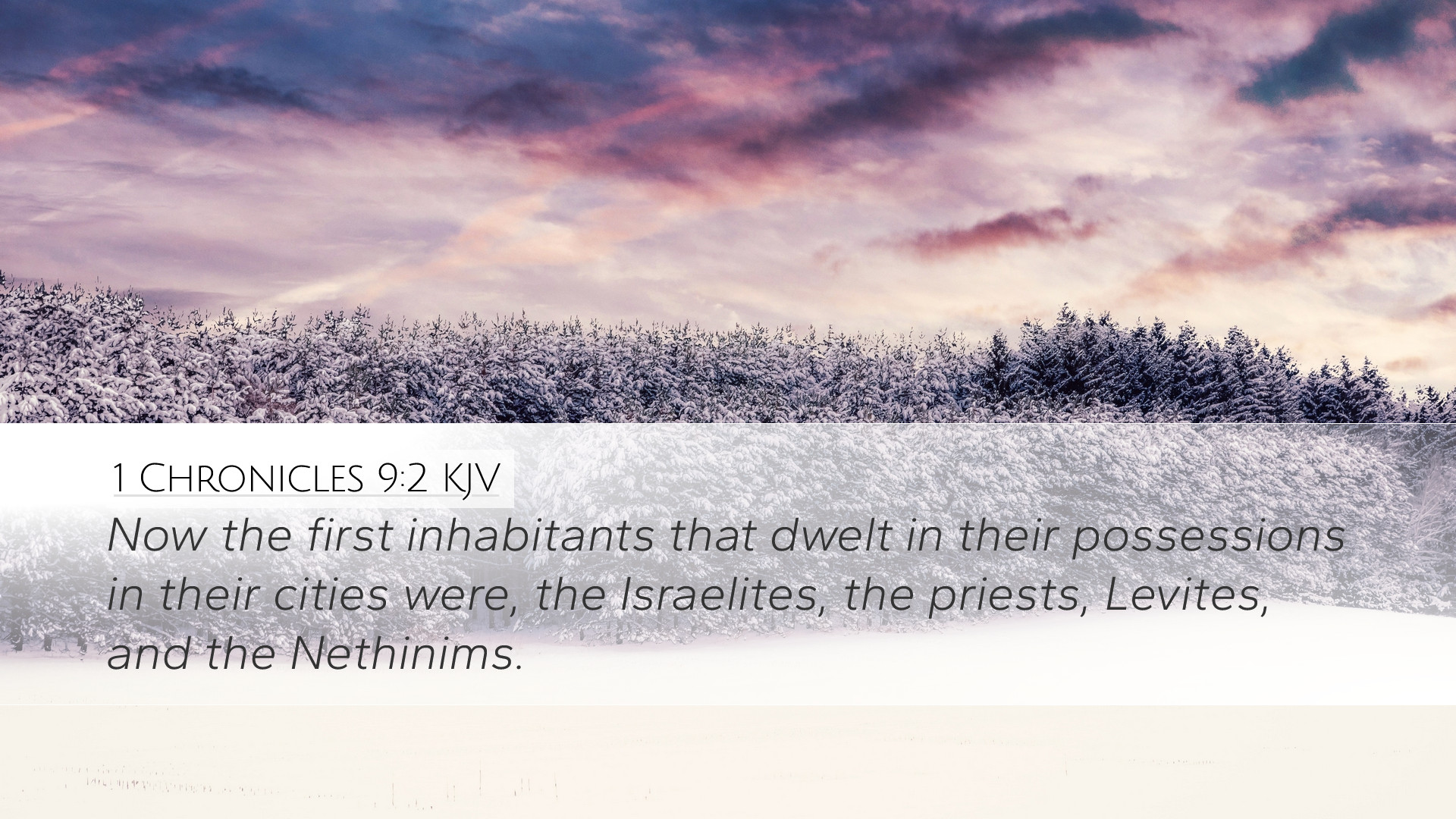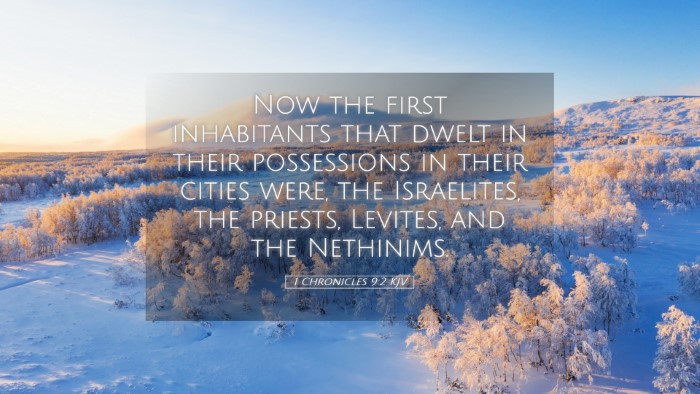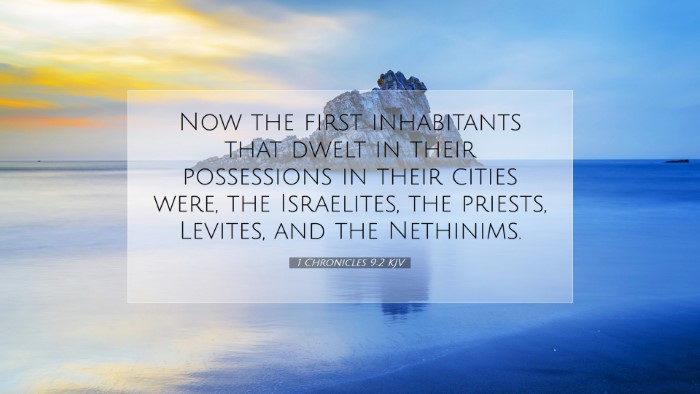Commentary on 1 Chronicles 9:2
1 Chronicles 9:2 states: "Now the first inhabitants that dwelt in their possessions in their cities were Israelites, the priests, and the Levites, and the Nethinims." This verse plays a crucial role in the understanding of the return of the Jewish exiles from Babylon and their settlement in the Promised Land, as well as assigning roles and responsibilities within their society.
Contextual Background
This passage is set against the backdrop of post-exilic Israel, where the emphasis is on restoring the nation and its worship. As the Jewish people returned from their Babylonian exile, it was critical to re-establish not only their territorial possessions but also their social and religious structures. The chronicler aims to show that the resettlement was orderly, focusing on specific groups within the Israelites.
Insights from Matthew Henry
Matthew Henry highlights the significance of the returning exiles as the initial inhabitants of the cities. He notes that this return was not merely about physical relocation but also included a spiritual restoration and a rededication to God’s covenant. The inclusion of priests, Levites, and Nethinims shows God's provision for a structured worship environment where the sacrificial and ceremonial laws could be fulfilled.
- Priests: Henry emphasizes the role of the priests in mediating between God and man, underscoring the importance of their presence in the community.
- Levites: He points out that the Levites were vital as helpers to the priests, facilitating the worship system.
- Nethinims: The mention of Nethinims signifies those dedicated to temple service, indicating a multi-faceted ministerial approach welcomed in the restoration.
Insights from Albert Barnes
According to Albert Barnes, this verse illustrates divine order in the restoration of the Israelites in their cities. Barnes explains how the chronicler not only documents the return but reinforces the roles assigned to various groups, which indicates a reorganized society under God's guidance. His commentary brings out the following points:
- Representatives of Worship: Barnes argues that the organization of these groups reflects an intentionality about worship, ensuring that it is maintained at the forefront of the community's values.
- Historical Reflection: He suggests that this historical account serves a dual purpose: it records the past for posterity and teaches contemporary lessons about faithfulness in service to God.
- Importance of Structure: Barnes also notes the need for structure in community life, particularly after a period of exile, as a means of restoring both identity and religious observance.
Insights from Adam Clarke
Adam Clarke contributes an insightful approach by analyzing the cultural implications of the return. He remarks that the listing of these inhabitants serves to solidify the identity of the returning exiles and denotes a return to their heritage. Clarke brings the following points to the forefront:
- Importance of Heritage: Clarke emphasizes that understanding the identity of these groups is essential for grasping the broader narrative of their historical journey.
- Significance of Leadership: He observes that the identification of priests and Levites underscores the importance of spiritual leadership during a time of reconstruction.
- Roles in Society: Clarke notes how the Nethinims, though often overlooked, played an essential role in temple service, reflecting the need for every member to fulfill their unique purpose within the community.
Theological Reflections
This verse beckons readers to ponder the significance of returning to God and establishing structured worship. The coming together of the priests, Levites, and Nethinims in this restoration reflects a collective dedication to God’s ordinances. The commentary from various scholars brings to light several theological themes pertinent to modern readers:
- Covenantal Continuity: The restoration of worship showcases the continuance of God’s promises and His faithfulness to the covenant people.
- Restoration and Renewal: The act of returning home is deeply symbolic of spiritual revival, illustrating how God invites His people to restore their relationship with Him.
- Community and Collaboration: This verse also emphasizes the collective aspect of worship and service to God, a poignant reminder of the communal nature of faith.
Practical Applications
For pastors, students, and theologians, 1 Chronicles 9:2 provides rich material for reflection on community structure in a contemporary setting. The need for organized, dedicated leadership among believers remains vital for fostering a vibrant community of faith. Here are some practical applications drawn from this verse:
- Promote Active Involvement: Encourage all members of the church to partake in serving, remembering that every role is meaningful in the eyes of God.
- Framework for Worship: Establish clear leadership structures within church ministries to ensure effective worship and service.
- Heritage Education: Teach congregants about the historical foundations of their faith and the importance of their role within the larger narrative of the church.
Conclusion
1 Chronicles 9:2 serves not only as a historical insight into the post-exilic community of Israel but also as a rich source of spiritual encouragement and organizational wisdom for today’s believers. By gleaning insights from the works of Matthew Henry, Albert Barnes, and Adam Clarke, we can appreciate the multifaceted dimensions of worship, service, and community that remain relevant throughout the generations.


